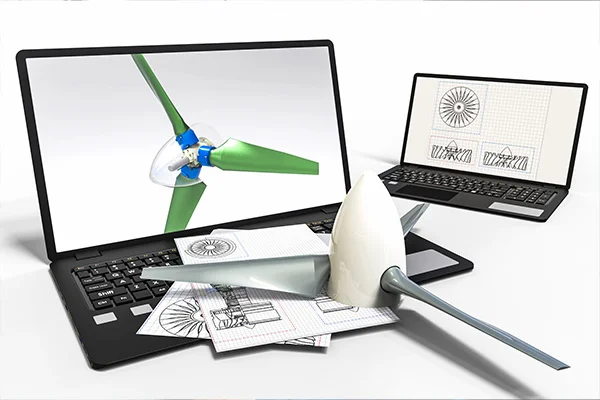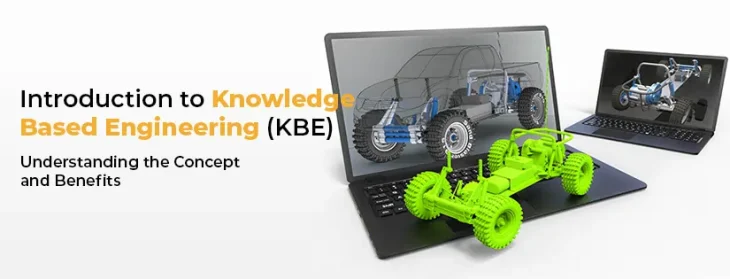5 Ways Knowledge-Based Engineering (KBE) Can Streamline Product Development
Table of content Introduction 5 Effective Strategies to Streamline Product Development Through KBE Conclusion Introduction Companies always look for ways to enhance efficiency and optimize product development processes. Knowledge-based engineering helps manufacturing companies boost overall performance in today’s dynamic, technology-driven environment. It automates design, analysis, and decision-making by fusing engineering expertise with cutting-edge computational techniques. This article will examine five crucial ways of knowledge-based engineering that can speed up product development. Increased productivity, lower costs, and shorter time to market are the standout benefits of incorporating this technology. 5 Effective Strategies to Streamline Product Development Through KBE: Are you looking to streamline your product development process? Discover how Knowledge-based engineering (KBE) can revolutionize your approach with these five key strategies: Automated Design and Optimization One of the primary benefits of knowledge-based engineering is its ability to automate the design process. It captures and encodes engineering knowledge into rule-based systems to generate designs following predefined constraints and requirements. It eliminates repetitive manual design iterations, significantly reduces human error, and accelerates the entire process. You can leverage parametric modeling techniques to create design templates with adjustable parameters. These templates serve as the starting point for generating multiple design alternatives. Engineers can modify the parameters for the KBE system to adjust the design automatically. This iterative process encourages rapid exploration of design options without requiring manual modifications at each step. Additionally, the system integrates optimization algorithms to explore design spaces and identify optimal solutions. The system can define design objectives and constraints to refine the design and achieve the desired performance metrics iteratively. This approach saves, improves product performance, and reduces development time. Standardization and Reusability Knowledge-Based Engineering promotes standardization and reusability of design elements, components, and workflows. Organizations can establish a consistent design methodology across projects, departments, and locations by codifying engineering knowledge into reusable modules. This standardization ensures product quality and allows for the seamless transfer of knowledge between teams. This methodology accelerates the development process. Using KBE systems, you can create design libraries that act as repositories of verified and improved design solutions. These collections include modular elements, including CAD templates, simulation models, and 3D models. Engineers can use the components from these libraries to speed up and simplify their design processes. Reusing pre-validated components across many projects ensures consistency and dependability. Enhanced Collaboration and Knowledge Sharing Collaboration is crucial in product development, especially in large organizations or projects involving multidisciplinary teams. Knowledge-based engineering provides a platform for engineers from different domains to share and access engineering knowledge. Engineers can collaborate in real-time, exchange design information, and perform concurrent engineering tasks. They can also contribute their expertise to the overall product development process. KBE systems commonly include features like version control, document management, and communication tools. These capabilities assist engineers in collaborating on design projects and accessing the most recent design information. They can also offer their perspectives through this system. Engineers from various specialties like mechanical, electrical, and software engineering can collaborate and work seamlessly. It helps reduce communication gaps and also streamlines decision-making. Furthermore, KBE systems can capture and document the rationale behind design decisions. It helps preserve valuable engineering knowledge to share across the organization. Lessons from previous projects can be stored as design rules, best practices, and simulation models. It allows engineers to build upon existing knowledge. KBE enhances product development processes’ overall efficiency and effectiveness by facilitating knowledge sharing and collaboration. Optimize Performance and Efficiency Efficient design tools must perform at their peak to handle intricate 3D models, big assemblies, and computationally demanding activities. The main goal of CAD software development should be performance optimization. Reduce computing complexity and memory utilization by using algorithms and data structures. Use approaches like spatial indexing, effective mesh representations, and level-of-detail algorithms to ensure quick rendering and easy interaction with the CAD models. Utilize the power of contemporary hardware by using multithreading and parallel processing. You can use several CPU cores and GPUs for quicker computations. The user experience can be further improved through asynchronous processing and background jobs. They can deliver responsive interfaces even during computationally demanding operations. Design Validation and Verification Product development involves numerous design iterations and validation steps to ensure the final product meets the desired performance and safety requirements. Knowledge-based engineering simplifies the design validation and verification processes by directly integrating computational tools and simulations into the design workflow. It can embed engineering rules and simulation models to automatically evaluate design alternatives. It also helps you perform virtual testing and assess the product’s behavior under various operating conditions. KBE systems enable engineers to define design constraints and requirements upfront. These constraints can include factors such as material properties, stress limits, and geometric tolerances. During the design process, the KBE system continuously checks the design against these constraints, providing real-time feedback to the engineers. Instant feedback helps identify design issues early in the development cycle, reducing the risk of costly errors and rework. KBE systems also use simulation models to forecast the product’s performance before building prototypes. The design procedures incorporate finite element analysis (FEA), computational fluid dynamics (CFD), and other simulation methods. Engineers can evaluate structural integrity, thermal behavior, and fluid flow characteristics. There’s less need for physical prototypes, and it saves time and money by doing virtual testing and analysis. Embrace Open Standards and Integration CAD software rarely operates in isolation. It often needs to interact with other software systems and exchange data with external tools. Embrace open standards and interoperability to integrate with commonly used file formats, industry-specific standards, and collaboration platforms. Support file import/export in common formats, including STEP, IGES, and STL, to ensure interoperability with various CAD systems and manufacturing procedures. Create APIs and SDKs that let outside developers add features to your CAD program or incorporate it into broader software ecosystems. Utilize existing libraries and frameworks for performing typical CAD tasks. You can also use it to collaborate with industry groups and communities to maintain current standards. Your CAD solution can benefit from integrating analysis tools, simulation software,
Read MoreRevolutionising Engineering Design: The Role of AI & Machine Learning in KBE
Table of content Introduction Understanding Knowledge-Based Engineering (KBE) AI and Machine Learning in KBE Benefits of AI in KBE Challenges and Considerations Conclusion Introduction One industry where artificial intelligence (AI) has made significant strides is engineering design. With the advancement of machine learning algorithms, AI is redefining how engineers approach design difficulties, leading to more practical and innovative solutions. In this article, we embark on an exciting voyage into knowledge-based engineering (KBE), where artificial intelligence (AI) and machine learning take centre stage. Get ready to see how the field of engineering design is being revolutionised. Prepare yourself as we examine how AI and machine learning algorithms are rewriting the rules, seamlessly automating tedious jobs, and accelerating creativity to unprecedented levels. So, lets us dive in to know more. Understanding Knowledge-Based Engineering (KBE) By using a knowledge-driven system to automate engineering design processes, knowledge-based engineering (KBE) is a methodology. Developing design alternatives, automating design processes, and supporting decision-making depends on capturing and applying expert knowledge. To enhance the design process and boost productivity, KBE systems combine design guidelines, technical expertise, and computer algorithms to enhance the design process and boost productivity. So, let us explore the cutting-edge world where engineering and technology meet to create new possibilities for design. AI and Machine Learning in KBE KBE systems depend heavily on artificial intelligence, especially machine learning, which enables them to learn from data, spot patterns, and make wise decisions. Here are a few ways that AI and machine learning, through KBE, are revolutionising engineering design: Large amounts of data can be analysed using machine learning algorithms to improve designs. AI can produce design choices and choose the best one based on predefined criteria by finding patterns and relationships in data. This saves time and resources by eliminating the need for manual trial and error. A generative design method uses AI algorithms with limitations and goals to generate many design possibilities. Machine learning models can examine existing designs, draw lessons from them, and produce fresh design concepts better suited to specific needs. This creates new opportunities and enables engineers to investigate novel concepts that may not have been considered. KBE can capture and use expert knowledge to automate design processes with AI-powered expert systems. These systems can replicate expert human decision-making and offer advice based on pre-established norms and criteria. Engineers can create more effectively and efficiently thanks to AI, which uses the pooled expertise of specialists. Machine learning algorithms can analyse large datasets to uncover helpful information that might not be visible to human designers. AI can uncover novel design concepts or optimisation techniques that can result in advancements in engineering design by spotting hidden patterns and connections. This improves originality and creativity during the design process. Benefits of AI in KBE Utilise Knowledge-Based Engineering (KBE)’s (amazing) AI capabilities to accelerate your engineering design process. Bid adieu to manual labour and welcome greater productivity, exactitude, cost savings, and a spurt of invention. Let’s explore the fascinating advantages that AI offers KBE: KBE provides design templates, rule-based reasoning, and simulation tools to aid in the conceptualisation stage. Under established guidelines and limitations, engineers may quickly investigate potential design solutions, assess their performance, and come to wise conclusions. AI aids in cost reduction during the design and production phases by optimising designs and decreasing the requirement for physical prototypes. Simulators and virtual testing with AI capabilities can detect possible problems early on, saving time and money. Engineers can explore various design options and push the limits of what is conventionally thought possible thanks to AI-powered generative design. This encourages creativity and creates new engineering design opportunities. Challenges and Considerations Although using AI in Knowledge-Based Engineering (KBE) has many advantages, there are also significant difficulties and factors to take into account. In order to achieve successful integration and ideal results, these elements must be addressed. The following are some major issues to think about: The decision-making process of AI models can sometimes be opaque, making it challenging to understand the underlying reasons behind their recommendations. This can be a concern, especially in safety-critical engineering applications. As AI becomes more prevalent in engineering design, ethical considerations such as fairness, accountability, and transparency must be addressed. Designers should be aware of potential biases and unintended consequences of AI-powered systems. AI should be seen as a tool to enhance human capabilities rather than replace human expertise. Collaborative approaches that combine human creativity and judgment with AI- driven automation can yield the best results. Conclusion Knowledge-Based Engineering (KBE) technologies based on artificial intelligence are revolutionising engineering design. Engineers may efficiently use expert knowledge, produce creative solutions, and validate and optimise designs using AI. Incorporating AI in KBE provides enhanced efficiency, accuracy, cost savings, innovation, and continual learning. But dealing with issues like data quality, interpretability, ethical concerns, and successful human-machine collaboration is crucial. AI will become increasingly important in determining how engineering design will be done as it develops, allowing engineers to work more effectively, creatively, and successfully. Are you ready to revolutionise your engineering design process? Harness the power of AI and experience the benefits of Knowledge-Based Engineering (KBE) with Prescient. Contact us today to explore how AI-powered solutions can optimise your designs, improve efficiency, and unlock new levels of innovation. Let’s shape the future together!
Read MoreIntroduction to Knowledge-Based Engineering (KBE) – Understanding the Concept and Benefits
Table of content Introduction What is Knowledge Based Engineering? The Knowledge Based Engineering Process Benefits of Knowledge Based Engineering Conclusion Introduction The world of technology is rapidly evolving, with the latest developments occurring constantly. From automation to preference-based customisation, multiple upgrades in the field of engineering are helping companies deliver better and more efficient products to customers. One such development is the increasing use of Knowledge Based Engineering methodology. In the simplest terms, Knowledge Based Engineering is referred to the combination of artificial intelligence (AI), object-oriented programming, and CAD automation (computer-aided design). In this article, we have curated the complete details for you to understand the concept and benefits of KBE. What is Knowledge Based Engineering? Knowledge Based Engineering (KBE) is the latest engineering methodology that uses a computer-based system to gather, analyse, and use engineering knowledge to design and develop new products. This methodology has revolutionised the engineering industry by offering a more efficient and effective way of creating products. Based on scientific methods and proven technology, this allows automation and customisation of the product design to speed up the process and give better and more efficient results. It eliminates the need for repetitive design work by using design automation, allowing engineers to focus on more complex and creative aspects of the design process. Typically, KBE systems have two components: a knowledge base and a reasoning engine. The knowledge base includes the laws, knowledge figures, and models defining the engineering problem’s domain, and the reasoning engine uses this information to provide conclusions and solutions. KBE has been applied in various industries, including aerospace, automotive, defence, and healthcare. KBE systems include a user interface, a choice of inference rules, and a knowledge base. Data on product design, technical concepts, and production procedures are stored in the knowledge base. The Knowledge Based Engineering Process Often used in place of CAD customisation or CAD automation, the KBE process is entirely based on knowledge acquisition and use. The process involves the steps as follows: 1.Knowledge acquisition Collect knowledge from subject matter experts, books, journals, and other sources, then organise it so a computer can process it. 2.Knowledge modelling Use a knowledge representation language, such as rule-based systems or semantic networks, to model the learned information and determine the connections between the data and the rules that describe the engineering domain. 3.Knowledge integration Include the modelled knowledge in a KBE system with a knowledge base and reasoning engine, and store the knowledge there systematically. 4.Knowledge validation Test the KBE system against well-known solutions to validate it and ensure it generates accurate and trustworthy results. 5.KBE system deployment Install the KBE system that has been validated and instruct engineers on how to use it. Improve efficiency and quality by integrating the system into current engineering procedures. 6.KBE system maintenance Maintaining the KBE system on an ongoing basis will ensure its effectiveness. This will involve tracking its operation, updating the knowledge base and reasoning engine, and considering user feedback. Knowing the benefits of Knowledge-Based Engineering is equally important when you want to implement it to gain extended-duration benefits. Benefits of Knowledge Based Engineering Knowledge-Based Engineering system has multiple benefits, which are discussed below: Increased efficiency KBE automates time-consuming, repetitive procedures, cutting the time and effort needed to complete engineering jobs. Improved quality Improved qualityKBE offers an organised method for engineering, which reduces errors and raises the calibre of the finished product. Reduced costs KBE can aid in lowering the cost of engineering activities by automating procedures and enhancing quality. Enhanced collaboration KBE makes it easier for engineering teams to collaborate and communicate, allowing them to exchange best practices and information. Faster product development By automating design and analysis tasks and shortening the prototyping process, KBE helps quicken product development cycles. Increased innovation KBE may promote innovation by enabling engineers to explore more innovative solutions and giving them access to a wider variety of design and analysis tools. Improved decision-making KBE can help decision-making by giving engineers access to more precise and trustworthy data and analysis results. Better documentation By automatically gathering and arranging engineering knowledge and data, KBE can help enhance documentation by lowering the possibility of data loss or improper management. Improved customer satisfaction KBE can increase customer satisfaction by speeding up product development, cutting costs, and raising product standards. Conclusion Knowledge Based Engineering (KBE) is a mentality emphasising the value of knowledge and experience in engineering, not merely a technology or tool. KBE helps engineers be more productive, inventive, and successful while reducing the risk of mistakes and delays by fusing human knowledge with artificial intelligence. We at PreScient are dedicated to assisting businesses of all sizes and sectors in realising the full potential of KBE since it is the future of engineering. Whether you’re just getting started with KBE or hoping to advance your skills, our team of professionals can offer the advice, resources, and assistance you require to succeed. To find out more, call us right away.
Read More

